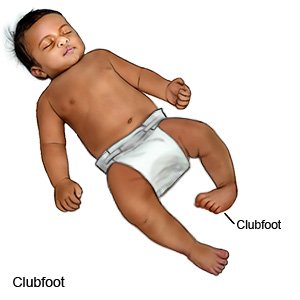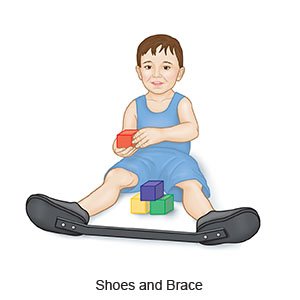Clubfoot
Medically reviewed by Drugs.com. Last updated on Aug 4, 2025.
Clubfoot is a congenital condition that causes your baby's foot to point down and be turned inward. The tendons in your baby's leg and foot are shorter and tighter than average. This causes the foot to be pulled into an incorrect position. One or both feet may be affected. Clubfoot can range from mild to severe.
 |
DISCHARGE INSTRUCTIONS:
Call your baby's doctor if:
- You have questions or concerns about your baby's condition or care.
Manage clubfoot:
Help your baby do stretching exercises provided by his or her provider. After casting, splinting, or surgery, he or she may also need to wear a brace for 3 to 4 years. A brace is a pair of shoes connected to a metal bar. Your baby will wear the brace for 23 hours every day for 3 months. The hour it is off is for when you bathe your baby. Your baby's provider may also recommend other activities he or she can do while the brace is off. Your baby will transition to wearing the brace when he or she sleeps at night and during naps. It can be difficult to make sure your baby wears the brace, but it is important so clubfoot does not return. The following can help make it easier to stay with the routine:
- Encourage your baby to walk and play in the brace. The way your baby walks will depend on the kind of brace he or she has. Some braces have bars that bend as the baby walks. You may be able to move his or her legs up and down to help him or her get used to the motion. Other braces have solid bars that do not move. You may be able to help by pushing and pulling on the bar to make his or her legs bend and straighten. Your baby may adjust to wearing a brace more easily if you play with him or her while he or she wears it.

- Create a brace routine. Tell your baby when it is time to put on the brace. Make it a regular part of getting ready for overnight sleep and naps. The brace may prevent your baby from sleeping well. Talk to his or her provider if you notice your baby is fussy or irritable from not getting enough sleep.
- Make your baby's foot comfortable. Check that his or her heel is all the way down in the shoe. Tighten the straps to make sure the heel does not slide. Your baby may have some redness at first from the shoes. Do not put lotion on your baby's feet. Lotion will make your baby's foot slide in the shoe. Check his or her foot a few times every day for blisters, sores, and redness. These may mean his or her heel is sliding in the shoe.
- Prevent your baby from getting out of the brace. Check that the straps and laces are tightly secured. It may help to have your baby wear 2 pairs of socks or to use socks with nonslip soles. You can also try removing the tongue of the shoe. You can make the laces harder to loosen by lacing the shoe from top to bottom.
- Make the brace safe. Put a pad on the metal bar. This will help protect your baby and anyone who is caring for him or her. It will also help protect furniture as your baby walks. Ask your baby's provider how to pad the bar and what to use for padding.
Prevent clubfoot in a future pregnancy:
Clubfoot often has no clear cause to prevent, but you can lower your baby's risk. Do not smoke cigarettes or take drugs while you are pregnant. To prevent other congenital conditions that may lead to clubfoot, take a prenatal vitamin. Start taking it at least 1 month before you get pregnant. Continue as directed through the first trimester. Look for prenatal vitamins that have at least 400 micrograms of folic acid. Folic acid helps prevent certain congenital conditions.
 |
Follow up with your baby's doctor as directed:
Your baby's foot will need to be checked regularly to make sure the clubfoot is not returning. Your baby's feet may need to be checked until he or she is finished growing. Write down your questions so you remember to ask them during your visits.
© Copyright Merative 2025 Information is for End User's use only and may not be sold, redistributed or otherwise used for commercial purposes.
The above information is an educational aid only. It is not intended as medical advice for individual conditions or treatments. Talk to your doctor, nurse or pharmacist before following any medical regimen to see if it is safe and effective for you.
Further information
Always consult your healthcare provider to ensure the information displayed on this page applies to your personal circumstances.
